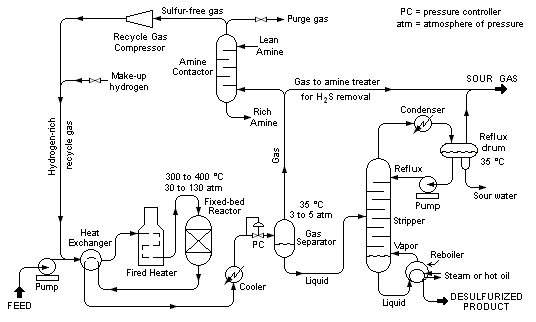
With emissions regulations becoming more and more stringent for diesel engines and new federal regulations that came into force in mid-2006, Shell Canada made a decision in 2004 to construct two new diesel hydrotreaters at two of its largest refineries in North America at Montreal East and Scotford.
The process involves the treatment of high-sulphur diesel with hydrogen over a catalyst. The sulphur reacts with the hydrogen to form hydrogen sulphide gas which is removed and treated to recover the sulphur, which is marketed for other industrial purposes (such as sulphuric acid production). The remaining treated diesel is then suitable for road fuel use having less than 15ppm of sulphur (a reduction of over 90%).
CONTRACTORS
Contracts were awarded to Fluor Canada Ltd for the project management at both of the refinery sites. The project at Scotford was carried out by Colt Engineering and the project at Montreal East was carried out by BPR Bechtel.
The new technology (distillate process technology) for the two units was developed by Shell Global Solutions (SGS), which is the technology subsidiary of the Royal Dutch Shell Group.
The construction of the hydrotreaters was completed at both sites during December 2005 and following commissioning they came on-line in March 2006 in time for the change in fuel regulations.
During the construction process there were a total of 1,800 construction engineers working on the two projects. This included 1,030 at Montreal and 770 at the Scotford site. The cost of the project to install the new hydrotreaters was estimated at $400m.
HYDROTREATING PROCESS
The raw diesel oil produced at the refinery contains more than 500ppm of sulphur and this is of course unacceptable. The diesel can contain the sulphur in a variety of forms but it is most likely to be as a range of organic sulphur compounds (thiols, thiophenes, organic sulphides and disulphides).
Ultra-Low Sulphur Diesel (ULSD), with levels of sulphur down as low as 15ppm, requires a very efficient desulphurisation process. The process relies on the vapour stage reaction of sulphur-containing organics over a molybdenum disulphide (catalyst is used with an alumina support and also has a small quantity of cobalt) or ruthenium disulphide catalyst in the presence of hydrogen.
Hydrogen has three important roles in the reactions – it can remove sulphide by forming hydrogen sulphide gas which is removed to recover the sulphur; it can also hydrogenate unsaturated compounds in the stream to produce better quality naphtha; and it can also carry out hydrogenolysis of certain undesirable compounds such as thiophenes.
PROBLEMS AT SCOTFORD
On 30 November 2007 Shell Canada reported that the recent problems with the upgrader that supplies synthetic crude oil to the 98,000bpd Scotford refinery had affected the supply of diesel fuel to the market that has created a shortage in some areas of Canada.
The problems started with a fire at the oil upgrader on 19 November 2007 when a gas leak caused the fire in one of the two residue hydroconversion units at the facility.
Shell Canada has had to arrange supplies of crude oil from other sources to maintain the feed to the refinery where production is now increasing as it has been operating at a minimum.
Randy Provencal, a Shell spokesman, said: "Production rates are gradually being increased as we get the feedstock that we needed.
It's gradual because it really depends on feedstock and these are units that do take time to reach higher rates."
EAST MONTREAL REFINERY
In November 2007 the Montreal refinery was started back up after an extended period of maintenance, which started on 5 October (work was complete by 5 November but the restart was delayed). The refinery ramped up to full 130,000pbd output by the end of November.



